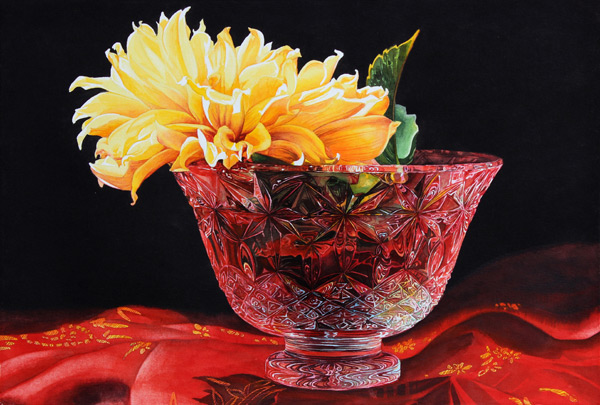How to Paint a Wild Sunflower in 7 Steps

This is the time of year where the earth breaks away to reveal fresh blooms. One such flower, the wild sunflower, offers beauty from top to bottom, bolstering vibrant yellow petals and lively green leaves.
Below, Mario Robinson shows how a combination of watercolors and a textured background can breathe new life into the already brimming wild sunflower. Enjoy!
Taming the Wild Sunflower | A Step-by-Step Demonstration
Each year I’m comforted by the thought of spring, which brings the sun’s warmth and blossoming flowers. The most exciting aspect of the burgeoning season is to witness the unexpected bloom of a random wild sunflower.

I recently noticed the bright yellow petals against the textured backdrop of my home’s cedar shakes. The thick green stalk climbed higher with each passing day. I was as enamored with the wing-like leaves as I was by the actual sunflower. An understandable amount of emphasis has been placed upon capturing the image of this beautiful flower. As I further investigated its anatomy, I realized the importance of its sizeable leaves. They give the wild sunflower an unrivaled majesty I find mystifying.
I’ll walk you through how I created the wild sunflower captured in my watercolor painting, Wildflowers.
Materials you’ll need:
Paints (Winsor & Newton)
- French ultramarine blue
- Cobalt blue
- Indanthrene blue
- Burnt umber
- Burnt sienna
- Payne’s grey
- Sepia
- Cadmium yellow
- Yellow titanate
- Lemon yellow (nickel titanate)
- New gamboge
- Neutral tint
Surface
- Arches 300-lb. cold-pressed watercolor paper
Brushes
- Winsor & Newton Series 7 (sizes 5, 7, 8, 9, 12)
- ¾-inch flat
1. Drawing Structure
I began by executing a detailed drawing of the flower and background. In order to expose the entire structure of the sunflower, I applied an initial wash using French ultramarine blue and burnt umber.
These two colors neutralize one another, resulting in a gray color, which can be adjusted to a cool or warm temperature by adding more of either blue or burnt umber.

2. Establishing Values
In an attempt to push the value range, I added two more glazes of the Payne’s grey and burnt sienna. I prefer to build my paintings using neutral layers of color prior to adding the full colors on my palette. This prevents my paintings from becoming too saturated with chroma.
In this stage of the watercolor, you can see various shapes forming through the use of value. In essence, certain objects are lighter or darker than others.

3. Finalizing the Underpainting
The delicacy of the flower is enhanced by the textured background. The purpose of this step was twofold: I finalized the texture of the underpainting and moved on to a darker mixture of colors to pinpoint the subsequent values of the sunflower.
Light runs through transparent objects and often tricks the eye into reading them as lighter in value than they actually are. My aim was to avoid this trap by identifying the juxtaposing object and then matching the flower’s value to it.

4. Applying Washes and Glazes
Once the value of the background was properly established, it was time to begin the task of bringing the wild sunflower along to match the value of the cedar shakes. I applied a wash of cadmium yellow to the flower petals and leaves. This was simply a starting point, as it set the course for subsequent glazes of color.
I made the early assessment that the temperature of the light was cool. Therefore, the green leaves are on the cool side of the spectrum. This decision informed each remaining application of glaze.
5. Adding Shadows
I employed the colors used for the initial block-in (French ultramarine and burnt umber) to add shadows to the sunflower’s yellow head and the texture of the leaves. Each leaf has a unique character, shape and color.
I wanted to spend time delving into the details of the leaves early on, as my finishing layers were simple glazes. Moreover, I introduced the shadow during this stage to give the appearance of depth between the sunflower and house.
6. Deepening Background Colors
The sunflower and leaves look lighter when I add deeper colors to the background. This shows the need to push various components of a painting to check questionable areas.
I worked wet-into-wet for the background. By applying a glaze of burnt sienna to the paper’s surface, I embellished a mixture of sepia, indanthrene blue and burnt sienna with a ¾-inch flat brush. This prevented the texture from appearing tight and regimented.
7. Finishing Details
I added the finishing notes of color to the central disk and the pleated rays. The transparent quality of watercolor is well suited for painting outdoor scenes.
Although light is captured in a unique manner in watercolor, it can be an impediment if the middle and dark values are not properly managed. The result can be a delicately rendered sketch rather than a finished work of art.

About the Artist

Mario Robinson is an exhibiting artist member of the National Arts Club, an artist member of the Salmagundi Club and a signature member of the Pastel Society of America. He is the author of Lessons in Realistic Watercolor (Monacelli Press) and is represented by Ann Long Fine Art, in Charleston, South Carolina; Arcadia Contemporary, in New York; and Morton Fine Art, in Washington, D.C. Learn more about Mario and his art by visiting his website.
***
This demonstration, written by Mario Robinson, first appeared in Artists Magazine. You can subscribe to the magazine here. And, order your copy of this specific issue here.





Have a technical question?
Contact UsJoin the Conversation!